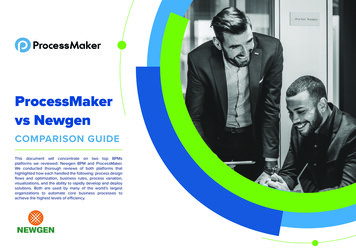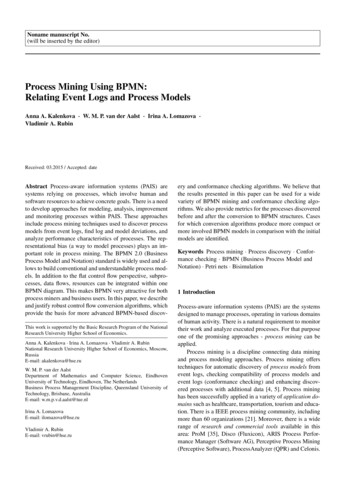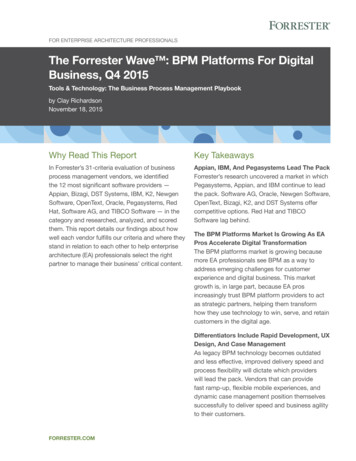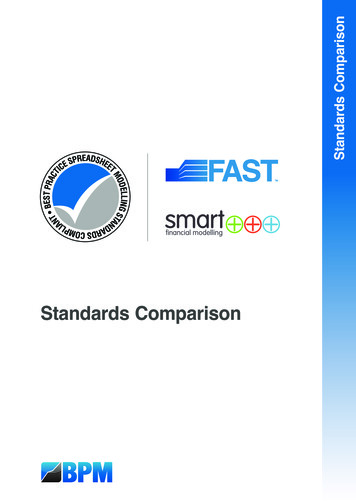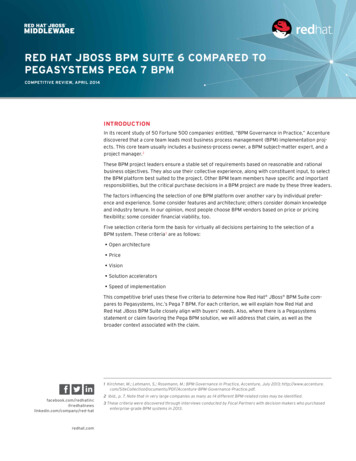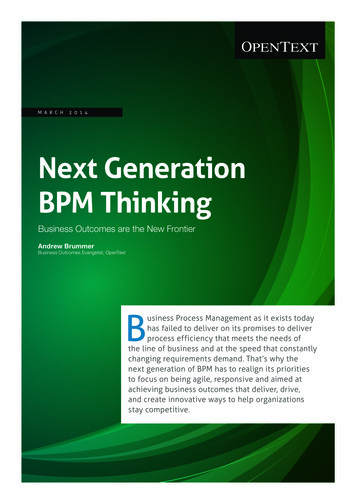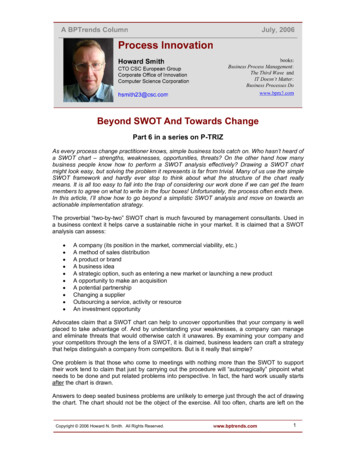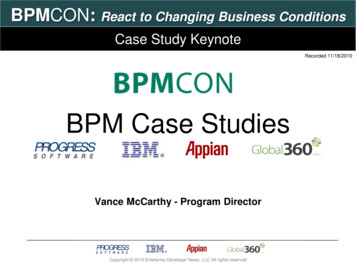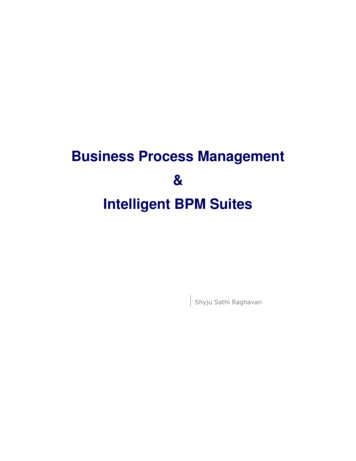
Transcription
Business Process Management&Intelligent BPM SuitesShyju Sathi Raghavan
Table of Contents1.BUSINESS PROCESS RE-ENGINEERING (BPR) . 32.BUSINESS PROCESS MANAGEMENT (BPM) . 43.THREE PILLARS OF BPM . 54.BPM LIFE CYCLE . 65.BPM SOFTWARE SUITES . 76.GARTNER MAGIC QUADRANT . 87.FEATURES OF MAJOR BPM SUITES. 98.TECHNICAL OVERVIEW OF IBM AND ORACLE BPM SOFTWARE . 109.IBPM SOFTWARE SUITES - COMPONENTS AND FEATURES . 119.1. BPMN Process Modeling . 119.2. SOA & Integration . 129.2.1. BPEL Process Implementation .129.2.2. Process Server / Process Manager .169.2.3. ESB .169.2.4. ESB Vs. Process Server - Which should you use? .169.3. Content Management . 179.4. Event Management . 179.5. Business Transaction Management . 179.6. Business Activity Monitoring (BAM) . 179.7. Business Intelligence (BI) . 179.8. Business Rule Engine (Process Rule Management) . 189.9. Social Media & Mobile . 1810.PROCESS EXAMPLE . 1911.BPM SUITE – BLOCK DIAGRAM . 21
1. Business Process Re-engineering (BPR)A business process is a set of logicallyrelated tasks perform to achieve a definedbusiness outcome.Every organization follows certain processfor achieving a defined business outcome.So,foranorganization,processimprovement is very much required. Theultimate aim of process re-engineering is toimprove the productivity or service, tobetter meets the needs of the customer.Apart from that employees may experiencegreater satisfaction at work due to morestreamlined and intelligent workflow. So,BPR is focusing of the analysis and designof workflow and process within anorganization.More recently the concept of BusinessProcess Management (BPM) has gainedmajor attention in the corporate world andit can be considered as the successor ofBPR.Shyju Sathi Raghavan
2. Business Process Management (BPM)BPM can be defined as a process centricapproach for improving businessperformance that combines informationtechnologies with governance methodologies.Generally in an organization, process champion or process experts driveinitiatives to change the process for improvement. But the implementationor getting it down to the lowest level is very difficult, even though theprocess champions come with an optimization. Also, for seeing the impactor result of the new process implementation takes long time. Here is theimportance of technology comes into picture. Using technologies likeapplication integration or SOA we can make this process faster and moreefficient.Apart from application integration human interaction in between theprocess is also important. So, there can be a long running or interactiveprocess which requires someone to take action or decision in between (So,the process flow is different from message flow. If the requirement is forprocess centric, we have to use process flow and if the requirement isdata centric, we have to go for data flow). As, BPM attempts to improveprocess continuously we can call it as process optimization process. BPMuses cross functional approach, so the work is automatically moves fromone desk to another in software point of view we can say, one applicationto another.Shyju Sathi Raghavan
3. Three Pillars of BPMThe three pillars of BPM are,People, Process and TechnologyProcess: A process can be defined as a chain of action for achievingcertain goal or result. While defining a process it has to satisfy alldemands of the customer.People: People are the one who own the process or who involves in theprocess. For example, customer, manager or it can be any one. The useror the customer has to input all the required information correctly;otherwise the system has to prompt. The manager has to approve thecustomer request on time, otherwise, his manager or the process ownerwill get an alert.For completion of a process, there can be multiple software applicationsinvolved. So, getting inputs from multiple applications is required fortaking decision in the process flow. According to the inputs from multiplesystems, the business flow takes action and move to the next step.Technology: As, I already explained, for completion of a process flow,multiple software systems can be involved. So these systems can beintegrated using technologies like SOA. Apart from application integration,process can be made more efficient and faster by using technologies nitoringdashboards, complex event processing, cloud, mobile, social media etc.Shyju Sathi Raghavan
4. BPM Life CycleBPM activities can be grouped into six categories,Vision, Design, Modelling & Simulation, Execution,Monitoring and OptimizationVision: Most of the organization would have goal and vision. So, theorganization vision study is important before process design. Functionsshould be defined according to strategic vision and goal of anorganization.Process Design: Process workflow has to be designed simple andstraight forward as possible.Process Modelling: Modelling is the activity of creating graphical processmodels using business process model notation (BPMN) and incorporaterule engine to create required business process rules. So, unlike the ESBflows, process flow graphical model includes human tasks, business rulesetc, apart from that the process flow can be persistent as well. Once it ismodelled using BPM Notation, it can be transformed into an executableBPEL process. In short, we can say, it is a kind of executable workflow.Simulation: Simulator helps to analyse and fine tune the businessprocess based on meaningful assumptions without having actualimplementation and execution of the process. Once modelled, a processmay go through a simulation exercise and observe how the processperforms giving a set of constraints. Simulation is mainly for determiningthe bottleneck and can improve the performance and reduce the cost ofprocess implementation.Execution: Once the simulation is completed, itis deployed during the execution phase of theBPM project.Monitoring and Managing: The BPM projectteam will monitor the business and see anythinggoes wrong.Optimization: If any problem arises, change willbe made for optimizing the process. This iscontinuous improvement.Shyju Sathi Raghavan
5. BPM Software SuitesBPMS BPM Software Suite is an integrated tool for designing, verifying,simulating, and operating business processes as well as automatingand improving them. By integrating existing applications, pulling relevant data, andconnecting appropriate people, process applications built with BPMsuites tend to overcome the limitations of traditional enterprisesystems. BPM Suites improves the quality of process by moving informationbetween enterprise software using technology like SOA An intelligent BPM Suite expands the traditional BPMS by adding thenew functionalities such as real-time business analytics, deepcomplex-event processing (CEP), social media to support socialbehaviour, big-data processing and expanded technologies to supportgrowing requirements for mobility.Shyju Sathi Raghavan
6. Gartner Magic QuadrantThis is the Gartner magic quadrant for intelligent Business ProcessManagement Suites. According to this, Pegasystem is the leader, followedby Apian, then IBM Lomoardi, then Bosch Inubit Suite, then Oracle BPMsuite, followed by Tibco, Software AG products like Aris and WebMethordsand so on.Shyju Sathi Raghavan
7. Features of major BPM suitesBPMS Apian BPM suites take full advantage of combination of social,mobile and cloud.Its look and feel is very good and it is user friendlyINUBIT SUITE Bosch Inubit Suite is strong is application integration. It has morethan 70 adapters.It had native support for popular middleware products and majorconnectivity standards. But the presence is more in Germany only.BUSINESS PROCESS MANAGER IBM Business Process Manager is very good in artefacts life cyclemanagement; also it had very good simulation capabilities. It isavailable in multiple versions like standard & express editions.IBM Business Process Manager is the successor to WebSphereProcess Server.BUSINESS PROCESS MANAGEMENT SUITE Oracle BPM Suite has several integration capabilities includingComplex Event Processing, Business Rules, Real time optimizationetc.It is built on top of Oracle SOA Suite which is famous in the marketfor application integration.Shyju Sathi Raghavan
8. Technical Overview of IBM and Oracle BPM SoftwareThis is the technical overview of IBM Business Process Manager andOracle BPM Suite. If you look at below, you can see both are running ontop of Application Server (J2EE Open Standard Server). For IBM, it isWebSphre Application Server (WAS), for Oracle it is Weblogic applicationserver.For IBM Business Process Manager, WebSphere ESB is installed on top ofWebSphere Application Server and WebSphere Business Process Manageris installed and configured on top of WebSphere ESB.On the other hand, Oracle SOA Suite is installed and configured on top ofWeblogic application server and BPM Suite is running on top of SOASuite. Here you can install SOA Suite on top of WebSphere ApplicationServer as well as both are J2EE/Open standards.Shyju Sathi Raghavan
9. iBPM Software Suites - Components and Features9.1. BPMN Process ModelingThis is an example of process modelling using BPM Suite. Here you cansee BPM Notation is using for modelling. Once it is modelled, you canconvert it into BPEL Component notation for model drivendevelopment. The latest concept is executable BPMN. If, you are usingexecutable BPMN, BPEL conversion is not required.Here, the notation inside the red circle is a humantask, that is human interaction is required.This is a start process symbolThese are all represents service tasksThis is an exclusive gatewayApart from this there are lots of other notations are also available likesend tasks, receive tasks, business rule tasks etc. Multiple gatewaysare also available like inclusive gateway, parallel gateway, complexgateway etc.Shyju Sathi Raghavan
9.2.SOA & IntegrationBusiness Process Integration:A BPM Suite should be strong in SOAbased application integration and shouldbe rich in adaptors. Also, connectivityinfrastructure should be flexible and hasto follow connectivity standards. Apartfrom that BPM Suite should be supportmessage oriented middleware like IBMWebSphre MQ, Tortoise MQ, MS-MQ etc.In earlier slides, you have seen that Oracle BPM Suite is built on top ofSOA Suite and IBM Business Process Manager is built on top ofWebSphere ESB and it is integrated with WebSphere service registryfor SOA solution.9.2.1.BPEL Process ImplementationThis is an example of BPEL Process implementation. As I alreadyexplained, you can convert BPMN notation to BPEL process notation.Apart from that, you can directly drag and drop the components intoBPEL editor itself.Generally, BPMN is used when designing and improving the businessprocess, whereas BPEL is used when implementing it, In other words,BPMN is used by business analysts/business team whereas BPEL isused by technical team.Shyju Sathi Raghavan
This is another BPEL flow.In this image, the left side service is called an exposed service. That is,the service shown on the left side is the final output service that can beused by the user or another application.The right side services are called external services. That is the BPELprocess flow uses/invoke these services.Generally, by combining all these services are called partner links.As I have explained, BPEL flows are actual implementation. That is whyyou can see operation name on the service image. These operationnames are coming from the service definition (For example WSDL).Here the middle portion is the designer window which is calledcomponent lane or swim lane. You can drag and drop componentsfrom component pallet to this window.The component pallet can have activities and components. There aremultiple types of activities like assign activity, invoke activity, receiveShyju Sathi Raghavan
activity etc. It can be components like Business Rule component,Human Task component, Mediator Component etc.The BPEL tool is mainly for service orchestration. If you take a typicalexample for loan process flow, the flow may need to contact withmultiple external services. For example, credits check service,blacklisted check service etc. Also, the service can be data enrichmentservice as well. So, this service orchestration includes business logic aswell like if the value of response from service-1 is xxx then invokeservie-2 else invoke service-3 etc.In this image, the component inside the red circle iscalled a Mediator. That is the purple coloured one.Mediator itself is a lightweight framework that has lotsof features including the normal ESB features likerouting, transformation etc.This is the BPEL process service component, theblue colour one.I you double click this component, it will open theBPEL Code Flow, which contains the flow of thebusiness logic that includes various programcomponents like Switch-case, If-else component etcand also contains various tasks components likeAssign task, receive task etc).Shyju Sathi Raghavan
The flow looks like this. You can double click each ofthese components and configure. According to thatunderlying XSLT code will be generated. Also, in thisflow, you can see lots of and – signs. That is forexpanding and shrinking the swim lanes exactlysimilar to sub flows.The yellow coloured components are Business Rulecomponents. This will be connected with a rule engineand the rule engine contains decision table.The green coloured one is Human Task component.Whenever BPEL process required a human interaction,the approval request will go to the specific user andlies in his tray. He has to login and has to do thenecessary action for process continuation. Until thenthe process will wait.Shyju Sathi Raghavan
9.2.2. Process Server / Process ManagerOnce you complete the model driven development/BPEL development,you can build and deploy it into the process server.In earlier slide, you have seen that SOA Suite is installed andconfigured on top of Weblogic Application Server or WebSphereApplication Server. The SOA Suite includes ESB (OSB) and BPELProcess server. In short, the process server contains serviceorchestration engine (BPEL Engine) and it runs on top of applicationserver, layers on top of SOA and SCA.Apart from that it follows industry standards like BPEL, XML, XSLT,XPath etc.9.2.3. ESBEnterprise Service Bus is an import component of BPM Suite, which isbasically using for message format transformation, message routing,communication protocol conversion etc.9.2.4. ESB Vs. Process Server - Which should you use?If the requirement is data-centric, an ESB is the clear choice and ifthe requirement is process-centric, BPEL is the clear choice.We should not use an ESB when state is required whereas BPEL hadability to have a long-running business process where state ismaintained (Human Task, Call Back Method)We should not use BPEL for handling large volume of messageswhereas ESB is designed to be able to handle large volumes ofmessages (IBM WebSphere Process Server misuse Stateless andState full)We should not include business logic in ESB whereas WS-BPEL canhandle more complex logic including business logic.BPEL had ability to handle Human Task and Business RulesShyju Sathi Raghavan
9.3. Content ManagementMost of the BPM Suites uses Content Manager for storing bulk images,videos, docs etc in a secured and organised way. Also, the contentmanager supports query language to access the content and it has sitecaching facilities for content integration. File format conversion is animport feature of Content manger, that is Doc to PDF, AVI to WAV, JPGto GIF etc.9.4. Event ManagementProcess Event is the occurrence of something in between the processthat usually requires action. The events can occur at the beginning,middle or the end of the process. It can be called as start event, middleevent and end event respectively. Each of these events is again subclassified into multiple categories. Event Driven Architecture (EDA) isthe leading technology for enabling events for your business process.Complex Event Processing (CEP) helps monitoring and analysing trendsand pattern at real-time. So, event management and Complex EventProcessing engines are important components of BPM.9.5. Business Transaction ManagementOne process workflowapplications involved ininfrastructure and theythe transactions pronefailures, errors etc.can have multiple system interaction. Thethe process flow are distributed across diversesupport Distributed Business Transactions, butto vanish without a trace because of delays,BusinessTransactionManagement(BTM) providestrackingtransactions across SOA. BTM supports Real-time tracking of eachtransactions and it follows transactions across all infrastructure andapplications.9.6. Business Activity Monitoring (BAM)Activity intelligence is the process of tracking real-time processperformance, create rich reporting dashboards, identifying processbottlenecks and optimise process efficiency flow.Business Activity monitoring helps to make better business decisionsand take corrective actions based on real-time information.Complex Event Processing extends the functionalities of BusinessActivity Monitoring by delivering real-time insight of the business.9.7. Business Intelligence (BI)Business Intelligence tools are for gaining business insight frombusiness data. Business Intelligence tool process the BigData and givesmore complete picture of the business.Shyju Sathi Raghavan
Oracle Business Intelligence Enterprise Edition is one of the famous BItools in the market, Oracle data integrator contains high performanceETL tool for processing & transformation, Oracle Golden Gate is a realtime BigData processor and it helps for operational decision making incertain situation. It also useful for compliance check, fraud check etc.9.8. Business Rule Engine (Process Rule Management)Rule driven BPM is an important concept. Rule engine helps to guideand implement process agility and ensure compliance. Rule engine isfor creating rules that support complex decision. The rules can bedynamically changed by the process owner. The rule engine can makedecision automatically based on the rule provided by the p
6. Gartner Magic Quadrant This is the Gartner magic quadrant for intelligent Business Process Management Suites. According to this, Pegasystem is the leader, followed by Apian, then IBM Lomoardi, then Bosch Inubit Suite, then Oracle BPM suite, followed by Tibco, Software AG products like Aris and WebMethords and so on.
